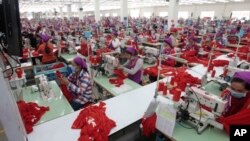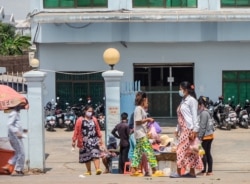As more than 180 factories have suspended operations or shutdown recently in Cambodia, affecting around 200,000 workers, Hong Kong-owned Ming Fai factory worked fast to find an alternative source of revenue to avert the global economic slowdown induced by the novel coronavirus pandemic.
The Kampong Speu-based factory manufactured products for hotels and airlines, and with global travel and tourism coming to a grinding halt, the factory needs to pivot soon. To remain open, the factory tweaked its production line to supply the global demand for surgical masks.
Em Sarat, a factory representative, said with limited access to export markets in the United States, the European Union, Singapore, and Australia, surgical mask production was the best solution for the time being.
“The demands for surgical masks are increasing on the buyer’s sides so that we added masks as another product from our manufacturing chain,” Em Sarat told VOA Khmer by phone from the factory in Kampong Speu’s Samraung Torng District.
Ming Fai is one of the three factories that have pivoted their operations to feed the demand for medical equipment globally. Roo Hsing Garment and Global Apparel and Textile (Cambodia) are the two other factories, but representatives for these companies declined to provide comment for this story.
If the factory had been unable to tweak its production line to make masks, Em Sarath said, there was no guarantee the approximately 2,300 workers would still be employed.
He added that demand for their old products, such as cloth slippers, socks, and eye masks, had dropped by as much as 70 percent, but with face mask production as many as 70 percent of their workers were still employed.
This is in sharp contrast to other factories, which have completely suspended operations for up to two months on account of low global orders or have shut down altogether, leaving workers financially helpless.
Cambodia is home to around 1,200 garment, footwear, and travel goods factories, according to Labor Ministry statistics, employing some 750,000 workers. Garment and footwear products are a key pillar of Cambodia’s exports, accounting for as much as 80 percent of trade with the European Union.
Amid the global novel coronavirus pandemic, the World Health Organization has reported the shortage of masks, protective gear, and ventilators, as global infections grew to 3.5 million cases this week.
This lack of personal protective equipment has hamstrung hospitals and medical facilities, especially in countries like the United States and Italy, and put the lives of medical personnel at risk.
Fadela Chaib, a spokesperson for WHO, said the organization encouraged the industrial switch to production of medical equipment when possible.
“We have seen many factories around the world switching their production to manufacture medical equipment,” Chaib told VOA Khmer in an email. “It is needed in these very special troubled times.”
But this production switch was not easy nor was it possible on a large scale, said Ken Loo, Secretary-General of the Garment Manufacturers Association of Cambodia.
“It is very difficult,” Ken Loo said. “First of all, the machines are completely different. Secondly, the requirement is also different because if you want to produce surgical masks you need to do it in a cleanroom. You do not do it in the open environment.”
He said it was not “simple” for factories to make this change and that in the interim, until orders and production returned to normal, there were not many factory owners could do in Cambodia.
Secretary of State at the Industry Ministry, Oum Sotha, said the government supported the initiative to transform production lines to manufacturing masks and other protective gear, admitting it was not an easy process.
“It doesn’t mean that they [factory owners] don’t want to,” Oum Sotha said. “But such conversions can be a challenge for some as they lack technicians and you cannot just do it overnight due to changes needed in production chains.
Ministry records obtained by VOA Khmer showed there were seven factories and seven workshops producing or seeking permits to produce masks and protective gear as of early April. Once fully operational, the records show they could produce at least 91.2 million medical masks, 17.8 million sets of protective clothing, and 9 million face shields a month.
These factories will now be able to export their products after the trade was suspended for five weeks, since March 30, and export permits were required.
Kun Nhim, chief of the Finance Ministry’s General Department of Custom and Excise, in a May 4 letter granting carte blanche to producers to export mask “because the Royal Government could manage and secure sufficient stockpiles of masks to serve the domestic fight against the COVID-19.”
While the production transformation can help workers, Yang Sophorn, president of the Cambodian Alliance of Trade Unions, said it needed to also ensure workers' safety, such as maintaining social distancing, to ensure that workers are not put at risk due to the pandemic.
“In the production workflow, items are either jointly worked on or passed from one [worker] to one another,” said Yang Sophorn. “This raises questions about safety and hygiene practice that requires the factories to be extremely vigilant.”
Back at the Ming Fai factory, despite the production switch to the now-in-demand masks, Em Sarat was unsure of its sustainability.
“As long as there are constant need and orders, we will still be producing masks – for now,” said Em Sarat, the factory’s representative.









